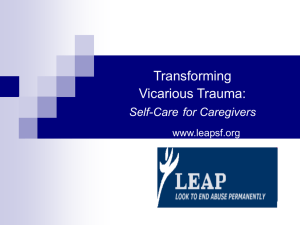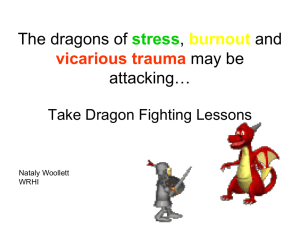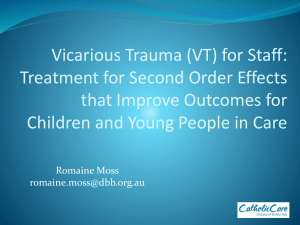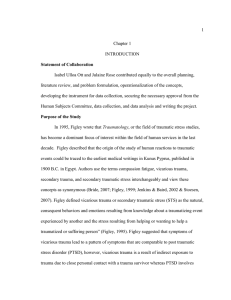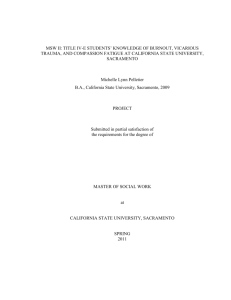Family Engagement Strategies When Engagement is Challenging
advertisement
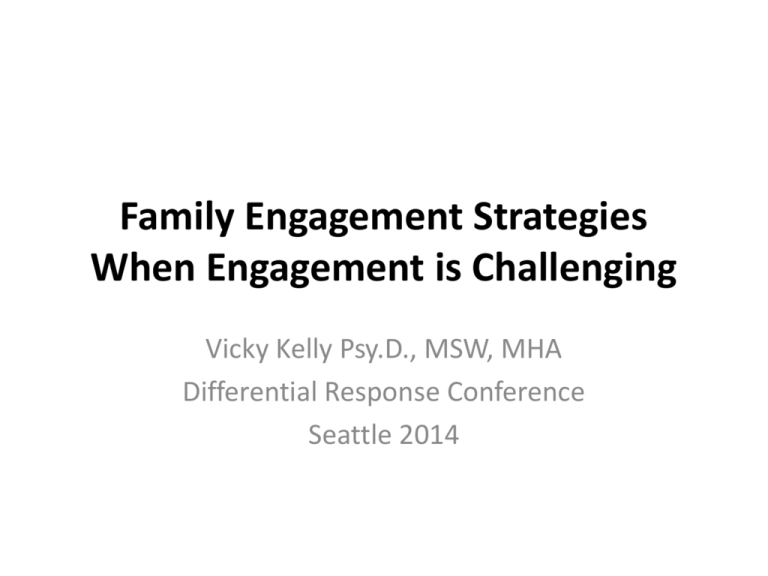
Family Engagement Strategies When Engagement is Challenging Vicky Kelly Psy.D., MSW, MHA Differential Response Conference Seattle 2014 Overview of the Workshop Identifying family engagement benefits and challenges; Understanding the foundations of intensive family engagement strategies; Using a parallel process perspective in understanding how to support workers; Framing and responding to burnout and vicarious trauma. Definition of Family Engagement Family-centered and strength-based approach to partnering with families in making decisions, setting goals, and achieving desired outcomes. It is founded on the principle of communicating openly and honestly in a way that supports disclosure of culture, family dynamics, and personal experiences in order to meet the individual needs of every family and every child. Child Welfare Information Gateway Why is Family Engagement Important? • Enhances helping relationship; • Promotes buy in; • Expands options; • Improves quality & focus of visits; • Improves placement stability; • Improves timeliness of permanency decisions; • Builds decision-making skills in families; • Enhances fit between family needs and services. (Child Welfare Information Gateway) Different Views on Family Engagement Criticisms Naïve focus on strengths in ways that fail to adequately appreciate harm and risks for the child. Rotten “apple” and rotten “tree” (i.e., can’t trust extended families) Values Way to deepen practice to promote full disclosure, so that assessments, planning, and interventions are responsive to the family’s needs and most likely to promote safety and real stability over time. Families and their support systems have significant potential resources for children. What we wished family engagement always looked like: What family engagement sometimes looks like when it is challenging Some of the families who most need our help are the hardest to engage Do they have to get better before we can help them? Continuum of Family Engagement Strategies Family Activities Family-Centered Family-Driven Levels of Engagement Strategies in Child Welfare Intensive Engagement Family Engagement Models Casework A Trauma-Informed Framework for Child Welfare Well-Being Trauma Permanency SAFETY Juggling Multiple Responsibilities What it means to be trauma-informed Moving from the question of “What is wrong with you?” to the question of “What happened to you?” and “How does that live on affecting your life today?” Remember: It’s Not About Me It’s About their Trauma The Social Brain and Engagement Safety/Reward Threat/Danger Thinking Brain Thinking Brain TOWARD Away Emotional Brain AKA the Survival Brain The “Gifts” of Trauma Conditioned Reactions Biased Perceptions Core Beliefs Secure in the World Others: Good, helpful, kind, trustworthy… Unsafe in the World Others: Hurtful, abusive, coercive, untrustworthy… Self: Good, deserving, lovable, competent… Self: Bad, undeserving, flawed, failure… World: Safe and predictable World: Dangerous and chaotic The Brain’s Ability to Change in Response to Experiences (Harvard Center on the Developing Child) The Compass of Shame Don Nathanson Attack Other Withdraw SHAME Attack Self Avoid How we think about clients has powerful impact on how we feel and do our jobs: Bad parents Resistant Difficulty meeting child’s needs right now Difficulty trusting help Manipulative Difficulty communicating needs directly Liar Difficulty telling whole truth Speed Bumps and Ruptures • Disconnections: thinking brains trying to communicate with survival brains. • Distortions: perceptions and beliefs interfering with current interactions & intentions. • Disillusions: feelings of helplessness & hopelessness reinforced. Strategies • Recognize and address emotional triggers; • Acknowledge that triggers feel like bad things from the past are happening now; • Be very explicit repeatedly about intentions; • Use activities that help calm & focus; • Reframe loaded negative labels; • Remember, there are no failures—only more information. Coping to Surviving to Transforming Meaningful Life Flexible Thinking Emotionally Regulated Shifting Focus Engaging and Supporting Workers Factors that Support Child Welfare Staff • Support is an important mediating factor against stress • Sense of personal and professional mission • Goodness of fit with agency • Supportive supervision • Investment in colleagues and agency • Involvement in agency • Empowerment • Humor & positive communications • Recognition and encouragement • Formal goal setting • Adequate resources The hard work of child welfare • • • • Role and value conflicts Exposure to pain and suffering Workload pressures External pressures Burnout (Maslack & Jackson 1981) 1) Emotional exhaustion 2) Depersonalization 3) Less sense of personal accomplishment Vulnerability of Child Welfare Staff to Burnout and Vicarious Trauma • Empathy • Responsibility • Exposure Emotional Labor Capacity for Empathy and Compassion …Hope for the “grace to see my reflection in the mirror of my clients, without becoming lost in it” (M. Formica 2009) Staying in/ Getting in the Boar A Monkey on the Back • Metaphor for when the client’s struggle becomes the worker’s Parallel Process Across the Organization (borrowed from the Sanctuary Model by Bloom) Self Reflection on Risk • Do I bear witness to the suffering of others on a regular basis? • Am I in a position where I feel responsible for someone’s safety or well-being? • Do I intuitively know—even if I’m not ready to say it out loud—that my work is starting to impact my life, health or relationships? • Do I work harder than is healthy for my mind and body because the issue feels deeply important to me? Risks to Organization: To what extent are these present? • • • • • • • Little sense of shared meaning or purpose; Culture of cynicism; Authoritarianism and rigid hierarchies; Culture of shame and blame; Defensive strategies create mistrust; Little tolerance for sharing positive emotions; Denial and hypocrisy; Making Stress Your Friend: New Research on the Stress Response TED Talk by Kelly McGonigal • How we used to think of stress; • What new research powerfully demonstrates: How we think about our physiological response to stress is the single biggest determinant of its impact. O O Possible Signs of VT • Loss of emotional control; • Physiological symptoms; • Over-identification with client’s trauma; • Denial of client’s trauma; • Feeling anxious and great vulnerability; • Disrupted beliefs; • Alienation & withdrawal; • Cynical & Disillusioned; • Impaired coping; • Avoidance; • Alterations in sensory experiences (e.g., intrusive imagery) Vicarious Trauma as an Occupational Hazard Occupational Hazards Long term effective work depends on our integrating self care into our work and our lives. Healthy habits; Appropriate physical activity; Journaling; Reflection, meditation and/or prayer; Intentional slowing down and choosing; Making pleasurable activities a priority. Emotionally & Physiologically Regulated • • • • • • • Diaphragmatic breathing Purposeful movement Bilateral stimulation of the brain Walking meditation Exercise Yoga Massage Reframing: How we label things matters! • • • • • • • Stressed Frustrated Exhausted Cynical Overwhelmed Traumatized Burned out • • • • • • • Not as calm Not as patient Not as rested Not as optimistic Not as on to of things Not as comfortable Not as inspired/ gratified Protective Factors for System • Establish and articulate values and principles; • Accept and acknowledge stressors; • Promote awareness of shared, noble intentions; • Engage those affected in developing solutions; • Promote connection, communication and celebration; • Join with others to maintain positive culture. Vicarious Success • We prosper from success; • We learn from observing others’ success; • Claiming and celebrating successes; • Building hope. Coping to Surviving to Transforming Meaningful Life Flexible Thinking Emotionally Regulated Be Intentional about your Purpose Even Super Man got to take off his cape! Careers as Marathons The most common way people give up their power is to believe they don’t have any. Alice Walker On the Path of Discovery Thank you! Victoria.Kelly@state.de.us Resources for Vicarious Trauma • Joyfulheart foundation.org • National Child Traumatic Stress Network • Ohio Child Welfare Training Program: Caseworker Readiness Activity • Saakvitne, Gamble, Pearlman, and Lev (2000) on vicarious trauma • Sanctuary Model and Dr. Sandy Bloom • Secondary trauma for caseworkers (Child Welfare Information Gateway) • Vicarious Trauma Institute
